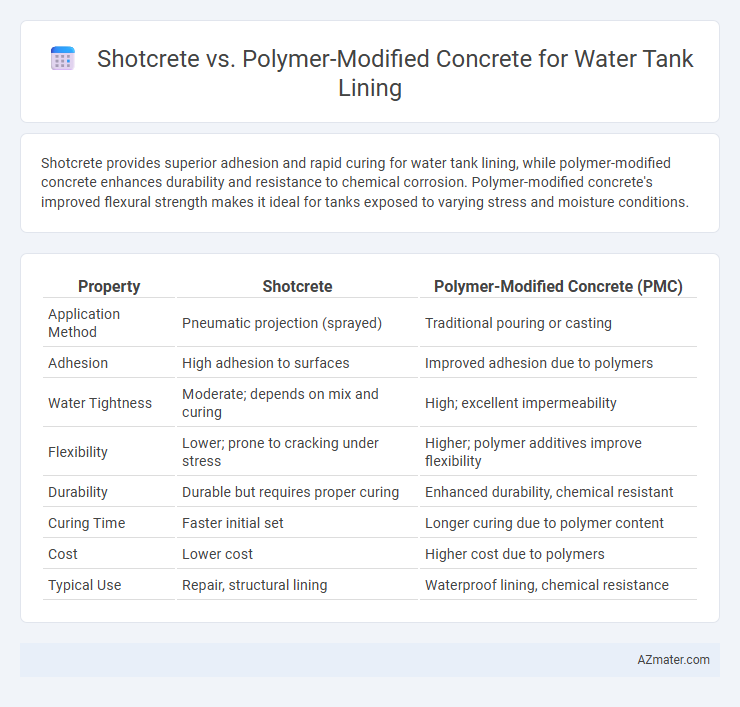Shotcrete provides superior adhesion and rapid curing for water tank lining, while polymer-modified concrete enhances durability and resistance to chemical corrosion. Polymer-modified concrete's improved flexural strength makes it ideal for tanks exposed to varying stress and moisture conditions.
Table of Comparison
| Property | Shotcrete | Polymer-Modified Concrete (PMC) |
|---|---|---|
| Application Method | Pneumatic projection (sprayed) | Traditional pouring or casting |
| Adhesion | High adhesion to surfaces | Improved adhesion due to polymers |
| Water Tightness | Moderate; depends on mix and curing | High; excellent impermeability |
| Flexibility | Lower; prone to cracking under stress | Higher; polymer additives improve flexibility |
| Durability | Durable but requires proper curing | Enhanced durability, chemical resistant |
| Curing Time | Faster initial set | Longer curing due to polymer content |
| Cost | Lower cost | Higher cost due to polymers |
| Typical Use | Repair, structural lining | Waterproof lining, chemical resistance |
Introduction to Water Tank Lining Solutions
Water tank lining solutions are essential for preventing leakage, corrosion, and contamination in potable and industrial water storage. Shotcrete provides a versatile, durable method with high adhesion and rapid application, ideal for repairing and lining complex tank geometries. Polymer-modified concrete enhances traditional concrete with polymers to improve impermeability, flexibility, and chemical resistance, offering long-term protection against water ingress and structural degradation.
Overview of Shotcrete Technology
Shotcrete technology involves spraying concrete pneumatically through a hose at high velocity onto surfaces, enabling rapid application and superior adhesion for water tank lining. This method allows for precise control of thickness and density, creating a durable, impermeable layer ideal for containing water and resisting leakage. Compared to traditional Polymer-Modified Concrete, shotcrete provides enhanced structural integrity and reduced curing time, optimizing water tank performance.
Understanding Polymer-Modified Concrete
Polymer-modified concrete enhances traditional concrete by incorporating polymers that improve adhesion, flexibility, and resistance to water and chemical damage, making it ideal for water tank lining. Unlike shotcrete, which is sprayed concrete primarily used for structural support, polymer-modified concrete provides superior durability and waterproofing properties critical for containing liquids. Its ability to reduce permeability and increase tensile strength helps prevent leakage and extends the lifespan of water tanks.
Material Composition and Properties
Shotcrete consists of a mixture of cement, sand, water, and aggregates sprayed pneumatically, offering high early strength and excellent adhesion, making it ideal for complex shapes in water tank lining. Polymer-modified concrete incorporates synthetic polymers like acrylics or styrene-butadiene, enhancing flexibility, impermeability, and chemical resistance compared to traditional shotcrete. The polymer content in polymer-modified concrete improves durability against water ingress and reduces shrinkage cracks, providing superior protection for water storage structures.
Application Techniques and Equipment
Shotcrete involves pneumatically projecting concrete at high velocity onto surfaces, making it ideal for applying thick, uniform layers in water tank linings with minimal formwork. Polymer-Modified Concrete (PMC) requires specialized mixing equipment to blend polymers with cement, enhancing adhesion and chemical resistance, and is typically applied using trowels or spray systems designed for viscous materials. Equipment for shotcrete includes air compressors and nozzle systems for efficient placement, while PMC demands mixers and sprayers capable of handling polymer additives to ensure consistent application and durability.
Performance in Waterproofing and Durability
Shotcrete offers superior waterproofing performance due to its dense application and excellent adhesion, minimizing water infiltration in water tank linings. Polymer-modified concrete enhances durability by improving flexural strength, chemical resistance, and reducing permeability, resulting in extended service life under aggressive water exposure. Combining shotcrete's application benefits with polymer modification maximizes both waterproofing efficacy and long-term structural integrity in water tank lining systems.
Chemical and Environmental Resistance
Shotcrete provides robust chemical resistance due to its dense matrix and rapid application, making it ideal for water tank linings exposed to aggressive substances. Polymer-modified concrete enhances environmental resistance by improving adhesion, reducing permeability, and increasing flexibility, which prevents cracking and water ingress under fluctuating conditions. Both materials offer superior durability, but polymer modifications significantly elevate resilience against chemical attack and environmental stressors in water containment systems.
Installation Time and Cost Considerations
Shotcrete offers faster installation for water tank lining due to its spray application method, reducing labor time and overall project duration. Polymer-modified concrete, while potentially more costly upfront, provides enhanced durability and chemical resistance which may lower long-term maintenance expenses. The choice between shotcrete and polymer-modified concrete depends on balancing initial installation speed and cost against longevity and performance needs.
Maintenance and Long-Term Performance
Shotcrete offers durable, seamless application with minimal maintenance, making it ideal for water tank lining due to its resistance to cracking and excellent bonding properties. Polymer-modified concrete enhances flexibility and chemical resistance, reducing the risk of deterioration and extending the lifespan under harsh water conditions. Long-term performance of polymer-modified concrete typically surpasses traditional shotcrete by providing improved impermeability and minimizing maintenance frequency in water storage environments.
Choosing the Right Lining: Key Factors to Consider
Selecting the appropriate lining for water tanks involves evaluating durability, water tightness, and resistance to chemical exposure. Shotcrete offers excellent adhesion and structural strength, ideal for irregular surfaces, while polymer-modified concrete enhances flexibility and crack resistance, ensuring long-term waterproofing. Considering environmental conditions and maintenance requirements is essential for maximizing the lifespan and performance of water tank linings.

Infographic: Shotcrete vs Polymer-Modified Concrete for Water Tank Lining
 azmater.com
azmater.com